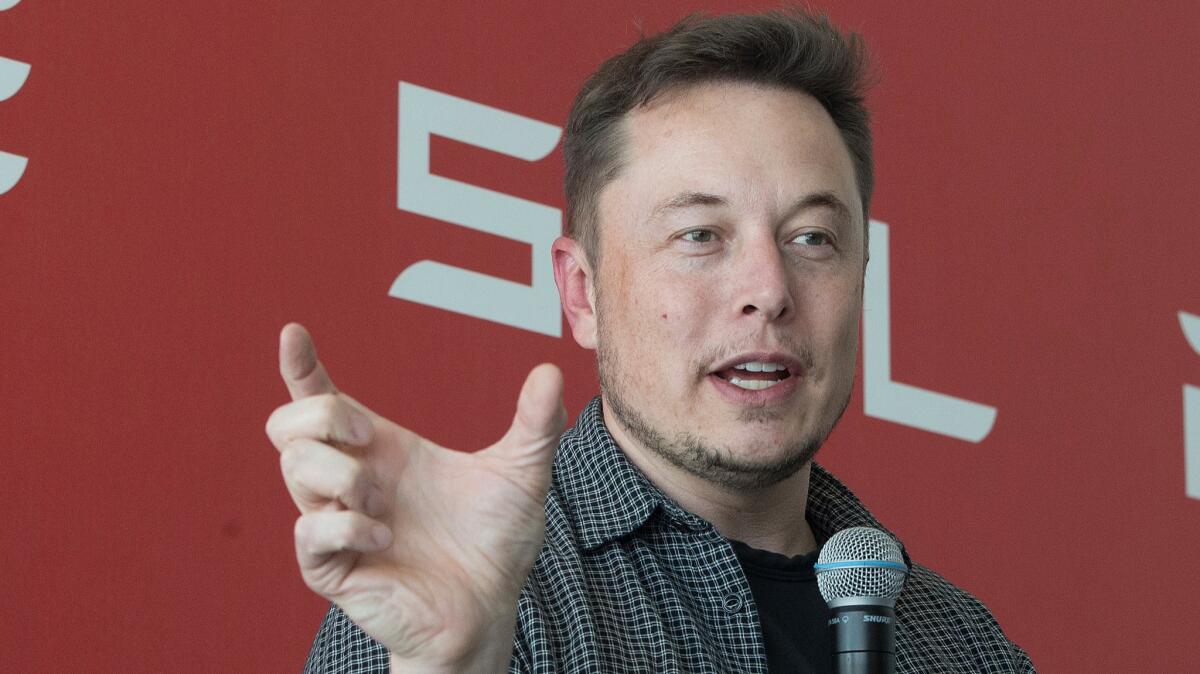Even more Ludicrous: Elon Musk says Tesla now has the world’s fastest production car

Elon Musk speaks at Tesla Motors’ giant battery factory outside Reno in July.
Reporting from San Francisco — Tesla Motors Chief Executive Elon Musk held a news conference Tuesday to announce that the company had shaved a few tenths of a second off its fastest car.
A Tesla Model S P100D equipped with “Ludicrous” mode will now go from zero to 60 miles per hour in 2.5 seconds, Musk said. The current model makes that jump in 2.8 seconds.
The car costs about $135,000.
Tesla customers who have ordered a P90D Ludicrous, but not yet received the cars, can upgrade to a 100-kiollowatt-hour (kWh) battery pack for $10,000. Existing P90D Ludicrous owners can also upgrade to a 100-kWh pack, but for $20,000, as their used 90-kWh packs will have to be recycled.
The new battery pack also is available for the Model X sport utility vehicle, whose off-the-line time is now said to be 2.9 seconds. “A seven-seater, that’s nuts,” Musk said.
The car, even selling in relatively low volumes, will improve free cash flow for Tesla, Musk said.
“This is an expensive car, but it’s what is paying for the Model 3,” Musk said. He suggested that Ludicrous buyers consider that “they’re helping to pay for” the Model 3.
In addition to speed, the range of the new model will increase to a maximum of 315 miles from about 300 miles — although no one will get near that mileage if they’re driving in Ludicrous mode.
The news, according to Tesla, is that the car is now the fastest production car in the world — and it’s electric.
Electric motors are known for high torque and rapid acceleration from a standing stop.
The speed and range boosts were made possible in part by increasing the battery’s energy density.
Last September, Tesla announced Model S battery improvements that included the blazing-fast Ludicrous mode, with a zero-to-60 time of 2.8 seconds. Technical details, not surprisingly, got little attention.
It’s the technical details, however, that could make or break Tesla as an ongoing concern.
Musk told reporters at the time that the recent improvements were the “result of improved cell chemistry” in that battery’s anode, which discharges electrons. Graphite has long been the material of choice for anodes, but silicon promises more efficiency — if engineers can make the tricky material work.
“We’re shifting the cell chemistry for the upgraded pack to partially use silicon in the anode,” Musk said at the time. “This is just sort of a baby step in the direction of using silicon in the anode. We’re still primarily using synthetic graphite, but over time we’ll be using increasing amounts of silicon in the anode.”
Musk has also talked in the past about its battery development as a steady process, with energy density improvements coming in at about 5% to 8% per year. That gives Teslas a longer driving range before recharge, at the same or lower cost.
Batteries are hardly Tesla’s only challenge. The company’s future rides on the mass-market Tesla 3. Though the car is scheduled to go on sale next year, major parts of the assembly line have yet to be built.




